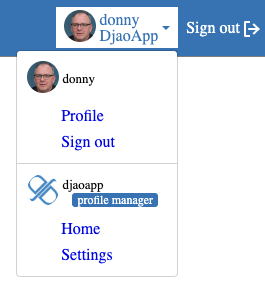Authenticated user dynamic menubar
- Skill required
- Basic Web Programming
In this tutorial, we will see how to integrate the dynamic menubar item in a DjaoDjin-hosted Website.
Prerequisites:
- URL for a Website hosted on DjaoDjin (ex: livedemo.djaoapp.com) - Register
- API Key to connect the hosted Website (ex: ABC***123) - How do I get my API Keys?
Notes on command line snippets
On command line snippets, lines starting with a $ character indicate
a shell prompt, or a command for you to type. Lines that do not start
with a $ character show a sample output from that command.
Example:
$ whoami
ec2-user
Text edits within source files are shown in universal diff format with lines preceded by a '-' sign to be removed and lines preceded by a '+' sign to be added. Example:
def set_default_profile(): # This line for context, to be kept as-is
- profile = 'abc' # This line to be removed
+ profile = 'cde' # This line to be added
return profile # This line for context, to be kept as-is
The full source code for this tutorial is available on GitHub.
Setting up
You should be familiar with the steps to setup your development environment, calling the hosted API from your local machine, and uploading your modifications to a live site. If it is not the case, I recommend you read the Write Javascript locally; test against hosted APIs tutorial first.
Inserting dynamic menu item for the authenticated user
The /api/users/{user}
endpoint has the ability to return a pre-rendered HTML menu item and dropdown
when called with a Accept: text/html HTTP header.
We thus need to:
- Set an anchor HTML element, which we will replace the inner content by the dynamic menu item in the HTML file (app.html)
- Write a Javascript snipset to call the
/api/users/{user}endpoint once a user is authenticated, and to replace the anchor HTML element inner content by the response from the API call.
In base.html
+ <ul id="userMenubarItem">
+ <li class="nav-item">
+ <a id="login" class="nav-link" href="{{'/login/'|site_url}}">Sign In</a>
+ </li>
+ </ul>
In auth.js
async function getDynamicMenubarItem() {
try {
const userMenubarItem = document.getElementById('userMenubarItem');
if( !userMenubarItem ) return;
const authToken = sessionStorage.getItem('authToken');
if( !authToken ) return;
const user = parseJWT(authToken);
if( !user.username ) return;
const resp = await fetch(apiUrl + '/users/' + user.username, {
headers: {
"Accept": "text/html",
"Authorization": "Bearer " + authToken,
}});
if( !resp.ok ) return;
// The assignment will replace the inner content
// of 'userMenubarItem' by HTMLElement, despite the response
// received (`resp.text()`) looking like it is being decorated,
// i.e. "<html><head></head><body>{{HTMLElement}}</body></html>".
const data = await resp.text();
userMenubarItem.innerHTML = data;
} catch(error) {
console.error(error.message);
}
}
// Make sure to include this script as the last node before the closing
// `</body>` tag, such that the DOM will be available when the following
// code executes.
(function() {
getDynamicMenubarItem();
})();
We start the local HTTP server
$ export DJAOAPP_API_BASE_URL="http://*_subdomain_*.djaoapp.com/api"
$ uvicorn main:app --reload
and browse to the URL serving the content (ex: http://127.0.0.1:8000/).
After logging in, you will see something like the following screenshots.


Publish the updates
The code works so let's publish it.
$ djd upload _livedemo_/templates _livedemo_/public
Summary
We have seen in this tutorial how to inject a dynamic menu item for an authenticated user into an HTML page.
To go further, you can customize the theme template used to generate
the dynamic menubar item HTML element by editing the _menubar.html
theme template. You can also build a dynamic menubar entirely from sratch
using the responses from API calls.
- Need help?
- Contact us
- Curious how it is built?
- Visit us on GitHub